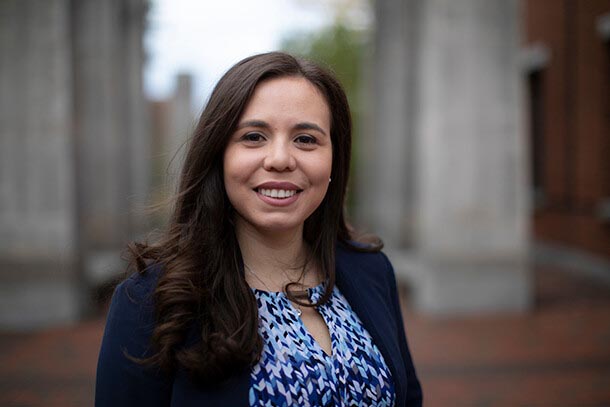
On July 1, Mariantonieta Gutierrez Soto joined Penn State’s Engineering Design program, an interdisciplinary education and research program housed within the School of Engineering Design, Technology, and Professional Programs (SEDTAPP), as an assistant professor. IMAGE: MARK CORNELISON | UKPHOTO
Building DREAMs: Smart-structures expert joins Engineering Design
8/11/2021
Samantha Chavanic
UNIVERSITY PARK, Pa. — As a child, Mariantonieta Gutierrez Soto was surrounded by successful role models — her grandmother built homes, her mother served as the director of a learning institute and her father, an electrical engineer, designed hydroelectric power plants. Inspired by their ambition, determination and achievements, Gutierrez Soto turned her interest in “remarkable civilizations worldwide and their signature structures that they are known for” into her passion, studying and researching smart building design and construction.
“I realized that civil engineering has the power to transform cities,” she said. “Civil engineering impacts day-to-day life — it brings water to your house, allows you to reach a destination, provides shelter. I focused on structural engineering since it has the mix of beautiful mathematical calculations with computer modeling to explore innovative designs and bring them to reality by understanding the requirements to ensure safety and serviceability.”
On July 1, Gutierrez Soto joined Penn State’s Engineering Design program, an interdisciplinary education and research program housed within the School of Engineering Design, Technology, and Professional Programs (SEDTAPP), as an assistant professor.
“Engineering design is interdisciplinary,” said Scarlett Miller, director of engineering design and associate professor of engineering design and industrial engineering. “Innovation occurs at the cusp of engineering design, as it serves as the connection point between engineering fields. Having Mariant’s expertise in civil engineering as part of our DESIGN program will not only provide students with a multidimensional design educational experience, it also will enhance our innovative and collaborative research capabilities as a program.”
Gutierrez Soto will teach and conduct research in civil engineering design areas, with an emphasis on structural design, biomimicry, natural disasters, game theory, control and machine learning. Her main research thrust will focus on the design of resilient, engineered, appropriate and multidimensional (DREAM) smart structures and communities.
“Natural disasters are significant challenges impacting the built environment and affecting people’s lives,” she said. “To tackle these real-life problems requires perspective from many disciplines. We (structural engineers and designers) aim to design resilient communities so that they bounce back and are engineered to solve problems. We want to appropriately design and build each structure because every community is different and multidimensional — buildings need to serve multiple functions that vary during normal or extreme events.”
Before joining Penn State, Gutierrez Soto served as an assistant professor of civil engineering at the University of Kentucky. There she formed the Smart Structures Research Lab and earned teaching recognitions for mentorship and making a difference.
While earning her doctorate in civil engineering from Ohio State, Gutierrez Soto served as a presidential fellow, a teaching facilitator for the University Center for Advancement of Teaching and resident director in the Office of International Affairs.
“We are very excited to have Mariant join the SEDTAPP faculty and help us build strong bridges to civil engineering,” said Timothy W. Simpson, SEDTAPP’s interim school head and Paul Morrow Professor in Engineering Design and Manufacturing. “She’ll help us expand the cornerstone experience to better serve first-year students that want to pursue careers in structural design and engineering, and her multi-pronged research expertise will help enable safer and more resilient structures and built environments. We need smart structures that can respond and adapt to climate change now more than ever.”
As part of her DREAM smart structure research, Gutierrez Soto applies concepts from nature to innovate within the intelligent build environment.
“Biomimicry aims to imitate patterns and strategies found in nature,” she said. “Smart structures bring structures to life. We equip buildings and bridges with technology so that they have the human-like ability to adapt in real-time during a natural disaster and fight back against the forces of nature. We are excited to bridge the gap of adopting this technology worldwide, potentially harvest energy from natural disasters, morph facades and adapt aquatic life into the design of communities and future extraterrestrial structures.”
Gutierrez Soto said she is thrilled to bring her structural design expertise to Penn State’s College of Engineering, as she believes the University and its faculty and students seek new, innovative heights and accomplishments. She said she was especially drawn to SEDTAPP’s unique interdisciplinary programs, research and academic offerings.
“Engineering at Penn State has a legacy of excellence in academic programs led by world-renowned professors,” she said. “I was attracted to the variety in the programs [in SEDTAPP] that train students in design, leadership, law and policy, engineering entrepreneurship and humanitarian engineering and social entrepreneurship. The DESIGN program impacts students’ learning starting with the first-year class, and I am looking forward to bringing exposure to the exciting DREAM research early on. I’m thrilled about sharing the office with colleagues with expertise in design, architecture, additive manufacturing, origami-inspired mechanisms, engineering education, biomedical, mechanical, industrial and so on, and the ideas developed through these unique collaborations.”



